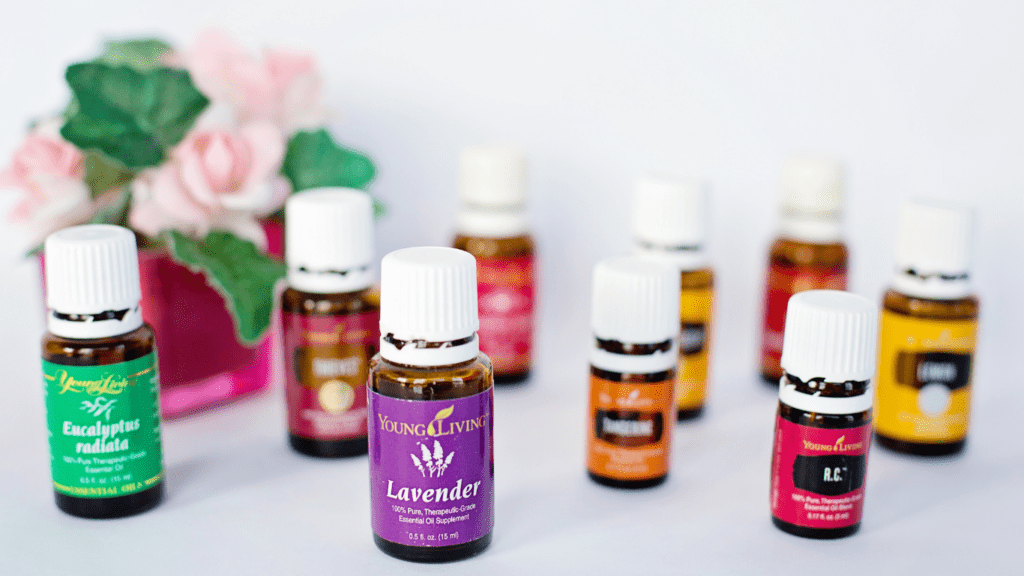What Are Essential Oils?
Essential oils are concentrated plant extracts that capture the essence of the plant’s scent and flavor. They’re commonly extracted through methods like steam distillation or cold pressing. These oils contain aromatic compounds unique to each plant, giving them distinct smells and properties.
Lavender, eucalyptus, and peppermint essential oils are well-known examples. Lavender oil is often used for relaxation and sleep, eucalyptus oil for respiratory issues, and peppermint oil for headaches and digestion.
Chemical constituents in these oils, such as:
- terpenes
- esters
- phenols
play key roles in their therapeutic effects. For instance, the menthol in peppermint oil has soothing properties. People often use these oils in aromatherapy, massage, and topical applications.
Safety is vital when using essential oils. They’re potent and should be diluted with a carrier oil (like coconut or jojoba) before applying to the skin. Additionally, it’s essential to consult healthcare providers before starting any new wellness practice, especially for those with medical conditions or who are pregnant.
Essential oils offer a natural way to support wellness, leveraging their potent plant-based properties efficiently.
Historical Overview Of Essential Oils
Essential oils have supported wellness for millennia. The ancient Egyptians were some of the first to use aromatic oils in 4500 BC, employing them for religious rituals, cosmetics, and medicine. These oils included myrrh, frankincense, and cedarwood, highlighting their significance in early culture.
In ancient Greece, Hippocrates, often regarded as the father of modern medicine, documented the benefits of over 300 plants. He used essential oils such as thyme, saffron, and marjoram in therapies and treatments, believing in their power to maintain health and well-being.
Romans also embraced essential oils, primarily focusing on their aromatic and therapeutic properties. They used lavender, rosemary, and peppermint in baths and massages to promote health and relaxation. This practice continued through the Middle Ages, evolving to incorporate more plants and refined extraction methods.
In the 19th century, the rediscovery of essential oils gained momentum in Europe. The French chemist René-Maurice Gattefossé coined the term “aromatherapy” in 1937 after observing lavender oil’s healing properties. His work marked a significant shift towards scientifically understanding and validating essential oils’ therapeutic effects.
Overall, the historical journey of essential oils—from ancient civilizations to modern scientific inquiry—highlights their enduring role in promoting wellness.
Popular Types Of Essential Oils

Essential oils offer a variety of benefits, each with unique uses. Key oils like lavender, peppermint, and tea tree stand out due to their versatile applications.
Lavender
Lavender oil, with its calming scent, promotes relaxation and alleviates stress. Historically used in aromatherapy, it also helps improve sleep quality. The oil contains linalool and linalyl acetate, which provide anti-anxiety and sedative effects. Evidence from studies published in the Journal of Alternative and Complementary Medicine supports lavender’s role in reducing anxiety and improving mood.
Peppermint
Peppermint oil is known for its invigorating aroma and cooling sensation. It soothes headaches and muscle pain due to its active ingredient, menthol. Additionally, it aids in digestion and relieves symptoms of irritable bowel syndrome (IBS), as highlighted by research in the British Medical Journal. Topically, peppermint oil relieves itching and inflammation.
Tea Tree
Tea tree oil, rich in terpinen-4-ol, boasts strong antimicrobial and anti-inflammatory properties. It’s effective in treating skin conditions like acne, due to its ability to reduce bacteria and inflammation. As reported in Clinical Microbiology Reviews, tea tree oil also treats fungal infections and serves as a powerful antiseptic.
How Essential Oils Support Wellness
Essential oils contribute to both physical and mental health, making them versatile tools for overall wellness. Let’s dive into their specific benefits.
Physical Health Benefits
Essential oils offer numerous physical health benefits. Eucalyptus oil, for example, supports respiratory health by easing congestion and improving airflow. Studies have shown that eucalyptus oil’s main constituent, eucalyptol, has anti-inflammatory properties that help soothe respiratory issues.
Peppermint oil aids digestion and alleviates symptoms of irritable bowel syndrome (IBS). The menthol in peppermint oil relaxes the gastrointestinal tract, making it effective in reducing discomfort from bloating and gas. Additionally, athletic individuals often use peppermint oil to relieve muscle pain and enhance physical performance.
Tea tree oil provides antibacterial and antifungal benefits. It’s particularly effective for treating skin conditions, like acne and athlete’s foot. The terpinen-4-ol compound in tea tree oil exhibits strong antimicrobial activity, making it a go-to solution for skin health.
Mental Health Benefits
- Essential oils also play a pivotal role in enhancing mental wellness.
- Lavender oil is well-known for its calming effects on the mind. Research indicates that inhaling lavender oil lowers cortisol levels, reducing stress and promoting relaxation. This can improve sleep quality, which is crucial for mental health.
- Rosemary oil enhances cognitive function and memory. Studies have found that 1,8-cineole, a primary component of rosemary oil, improves concentration and overall brain performance. This makes it an excellent choice for students and professionals seeking better focus.
- Bergamot oil alleviates symptoms of depression and anxiety. Research shows that its citrus scent elevates mood and promotes a sense of well-being. The oil interacts with neurotransmitters like serotonin and dopamine, which are directly linked to mood regulation.
- By incorporating essential oils into daily routines, users can enjoy comprehensive benefits that support both physical and mental wellness.
Methods Of Using Essential Oils
Essential oils offer various application methods, each contributing to wellness in different ways. Here are the primary methods to consider.
Aromatherapy
Aromatherapy uses essential oils’ scents to promote physical and psychological well-being. I use diffusers, humidifiers, or simple inhalation to disperse these oils into the air. For example, a lavender oil diffuser helps reduce anxiety and improve sleep quality. Many people find peppermint oil inhalation effective for clearing sinuses and enhancing focus. Whether at home or work, aromatherapy provides an accessible way to reap essential oils’ benefits.
Topical Application
Topical application involves applying diluted essential oils to the skin. I blend essential oils with carrier oils like coconut or almond oil to ensure safe usage. For instance, I apply tea tree oil mixed with a carrier oil to treat acne. Lavender oil diluted with a carrier oil soothes skin irritations when applied topically. It’s important to perform a patch test before applying any essential oil blend to the skin to prevent allergic reactions.
Ingestion
Some essential oils can be ingested to support internal health, but this method requires caution. I only consume food-grade essential oils approved for internal use. For example, I add a drop of peppermint oil to tea to aid digestion. Citrus oils like lemon and orange can be added to water for a refreshing drink. Always consult a healthcare professional before ingesting essential oils to avoid adverse effects.
Safety And Precautions
While essential oils offer numerous wellness benefits, it’s crucial to use them safely. The concentrated nature of these plant extracts can pose risks if not handled properly. Understanding these safety measures maximizes their therapeutic potential.
Dilution Is Key
Essential oils are potent and can cause skin irritation if applied directly. Diluting them with carrier oils, like coconut or jojoba oil, reduces this risk. A common rule is to use one drop of essential oil per teaspoon of carrier oil.
Patch Tests Prevent Reactions
Before applying a new essential oil to large skin areas, perform a patch test. Apply a small amount of the diluted oil to a discreet area and wait 24 hours. Redness, itching, or swelling signals a reaction.
Essential Oils And Children
Children are more sensitive to essential oils. Use lower concentrations and avoid specific oils, like eucalyptus and peppermint, which can cause adverse reactions in young kids. Consulting a pediatrician before use is advisable.
Pregnancy Considerations
Pregnant individuals should exercise caution with essential oils. Some oils, such as rosemary and clary sage, can stimulate uterine contractions. Always consult a healthcare provider to ensure safety for both mother and baby.
Internal Use Requires Caution
Ingesting essential oils should not be done without the guidance of a qualified professional. Food-grade oils that are safe for consumption require specific dosing to avoid toxicity. Misuse can result in serious health issues.
Storage And Shelf Life
Store essential oils in dark, glass bottles away from light and heat. Proper storage extends their shelf life, typically ranging between 1 to 3 years, depending on the oil. Check for changes in odor or consistency, which indicate degradation.
Interactions With Medications
Essential oils can interact with certain medications. For example, peppermint oil can affect the absorption of some medications. Always inform a healthcare provider about any essential oils being used to avoid adverse interactions.
Avoiding Phototoxicity
Certain citrus oils, like bergamot and lemon, can cause phototoxic reactions when exposed to sunlight. Avoid sun exposure for at least 12 hours after applying these oils topically to prevent skin burns or discoloration.
Safe Diffusion Practices
Using essential oils in diffusers should follow manufacturer guidelines. Overuse can lead to respiratory issues, especially in confined spaces. Limit diffusion to 30-60 minutes multiple times a day for optimal safety.
Following these safety and precautionary measures ensures that the use of essential oils is both effective and secure.



 Lead Forest Survival Specialist & Outdoor Educator
Timothy Peters is Whisper Forest Ways’ resident expert on wilderness survival and all things related to thriving in the outdoors. With a background in environmental sciences and over a decade of hands-on survival training, Timothy combines scientific knowledge with practical experience to teach readers essential survival skills, such as shelter building, fire making, and foraging. His approach emphasizes respect for the natural world and sustainability, ensuring that all of his methods encourage low-impact interaction with the environment. Whether you’re new to outdoor adventures or a seasoned explorer, Timothy’s detailed guides and insights provide invaluable knowledge for safely and confidently navigating the wild.
Lead Forest Survival Specialist & Outdoor Educator
Timothy Peters is Whisper Forest Ways’ resident expert on wilderness survival and all things related to thriving in the outdoors. With a background in environmental sciences and over a decade of hands-on survival training, Timothy combines scientific knowledge with practical experience to teach readers essential survival skills, such as shelter building, fire making, and foraging. His approach emphasizes respect for the natural world and sustainability, ensuring that all of his methods encourage low-impact interaction with the environment. Whether you’re new to outdoor adventures or a seasoned explorer, Timothy’s detailed guides and insights provide invaluable knowledge for safely and confidently navigating the wild.
